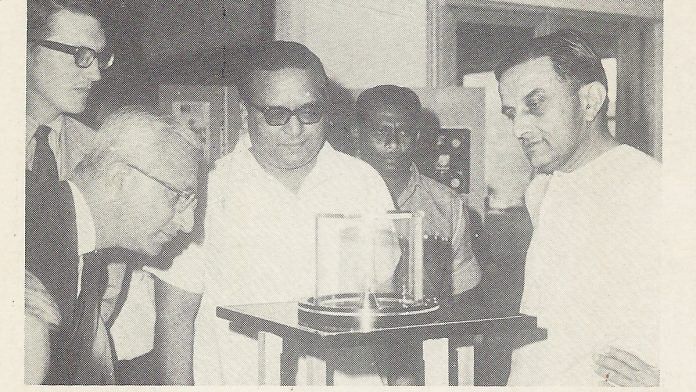Indian space enthusiasts are eagerly awaiting the soft landing of Chandrayaan-2’s Vikram lander on the south pole of the moon early Saturday (7 September). The lander’s name is steeped in the history of Indian science and is a tribute to the pioneer of the Indian space programme, Vikram Sarabhai.
Fifty years ago, Sarabhai was watching the successful landing of Apollo-11 and man stepping on the moon. Sarabhai called the event “as significant as when man learnt that the world is a sphere and that it is not at the center of the universe.” (‘Apollo-11 Model For Tackling Problems On Earth: Sarabhai’, The Times of India, 22 July 1969, P7)
As the chairman of Atomic Energy Commission of India at that time, Sarabhai underscored the importance of new scientific developments and noted that “our perspective of the universe must alter fundamentally when we understand how the solar system and the important objects were created…”
Appreciating the effort that went into the Apollo-11 mission, Vikram Sarabhai said: “No peace time project of this magnitude and sophistication has ever been undertaken on a comparable scale — hundreds of thousands of people worked on the Apollo project”.
But it was not the sheer scale or grandeur of the mission that fascinated him.
Instead, he saw Apollo-11’s success as a “model for the world on how practical problems like increasing food production and attaining an adequate standard of living could be tackled”. (‘Apollo-11 Model For Tackling Problems On Earth: Sarabhai’, ToI, 22 July 1969, P7)
Also read: Vikram Sarabhai, India’s space-man torn apart by the loss of Indira Gandhi’s trust
Gandhi & Apollo-11 mission
After the Apollo-11 crew safely returned to Earth on 24 July 1969, all its three members (Neil Armstrong, Buzz Aldrin and Michael Collins) along with their wives were sent on a 37-day tour of 22 countries, including India, by then US President Richard Nixon in a special White House jet. They visited Mumbai on 26 October and were greeted by a ‘wildly cheering crowd’ of more than 20,000 admirers at the city’s airport. As part of their itinerary, the troika visited the Tata Institute of Fundamental Research the same evening where they were received by Vikram Sarabhai and others from the Indian scientific community.
The year 1969 marked Mahatma Gandhi’s birth centenary and Neil Armstrong, commander of the Apollo-11 mission, invoked Gandhi on his arrival in India.
To a cheering crowd, Armstrong said, “Gandhi worked for promoting peace and brotherhood among men. The US air space programme was conceived in the same belief as a peaceful effort based on international co-operation, the fruits of which are to be shared by all mankind… In this way, space science and technology can make an important contribution to the fulfillment of Mahatma Gandhi’s dream”. (‘Moon Heroes Have Inspired Our Youth: Naik’, ToI, 27 October 1969, P5)
Also read: Nehru’s belief in science fuelled India’s ‘audacious’ space programme
Frenzy over a walnut-sized rock
Later that year, an exhibition displaying a rock collected from the moon’s surface was held at the USIS building (run by the US embassy), New Delhi. The enthusiasm was palpable. A walnut-sized lunar rock enjoyed VIP status.
“It landed under escort, was met at the airport by American GIs and Indian policemen, and was kept in the safest vault in the US embassy… Exhibited on a revolving disc in a gas-filled chamber and accompanied by commentary, the dry-grey coloured piece attracted many outside scientific fraternity. There were rumours about its authenticity and US ambassador clarified in a lighter vein that Americans were not ‘bamboozling’ Indians by substituting the lunar sample by an earth sample”. (‘Moon-rock sample on show in New Delhi’, ToI, 24 December 1969, P11)
R. Aravamudan, one of the first engineers selected by Vikram Sarabhai in 1962 for India’s space mission, recollected in his book ISRO: A Personal History that the rock was also exhibited at the Space Science & Technology Centre at Thumba. There was a mad rush of people outside the centre, wrote Aravamudan, and the local police had to be called to manage the crowd.
Also read: India’s Chandrayaan-2 matters, but don’t dream about moon picnics with friends just as yet
Sarabhai’s vision
Sarabhai’s vision for the Indian space programme was that it must earn international acclaim but be driven by real objectives.
On Apollo-11 mission’s success, he said, “It must make us not only jubilant but also reflect on its full significance”. (‘Apollo-11 Model For Tackling Problems On Earth: Sarabhai’, ToI, 22 July 1969, P7)
While delivering the Homi Bhabha Memorial Lecture, he informed the gathering that the Indian scientific groups had proposed to the National Aeronautics Space Administration (NASA) that “Indian-made equipment for performing certain important experiments be left on the moon in one of the Apollo missions”.(‘Indian Equipment For Tests On Moon Surface Proposed’, ToI, 30 December 1969, P4)
In a telling and dramatic turn of events half-a-century later, the Vikram lander of Chandrayaan-2 is carrying a NASA-supplied retroreflector to be put on the south pole of the moon, in order to continue a NASA experiment that began with the success of the Apollo-11 mission.
Also read: As Chandrayaan-2 readies for landing, ISRO chief K Sivan says why it will be ‘terrifying’
The author is a senior columnist and writer based in Ahmedabad. Views are personal.





Interesting peek into history. Thanks.